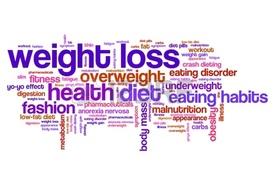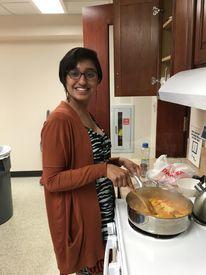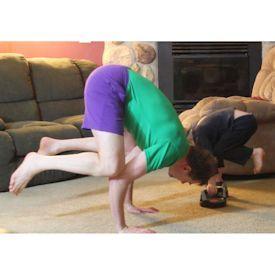What do people do for logging when you can't weigh the food you're eating?
Options

mustloseweight2015
Posts: 78 Member
So I know that the most ideal way to log the amount of food eaten is by weight. However, there are instances when it is difficult to weigh, like in restaurants. Also, I am particularly talking about a lot of cooked foods/entrees (particularly ethnic foods or other somewhat uncommon foods) in the MFP database that don't have the weight options when you try to select the quantity. It will only give you the options of cup/tbsp/or even worse "serving." I just wanted to know what people do when they encounter this? Do you then manually try to enter the recipes for everything?
0
Replies
-
I do the best I can to make reasonable estimates. That's all any of this is, anways... just estimating. Restaurant food will rarely be "accurate"... do the best you can and move on with your day.
Worst case scenario, I'll log/estimate high to give myself some room for error.0 -
I find something similar in the database (hopefully with a "cup" measurement because its easier to eyeball volume than weight). I estimate the volume of what I'm eating and usually add another 1/2 cup (or 1/4 cup if its a really small serving, like I think its only 1/2 a cup of rice or something) to that when I log it to give myself plenty of wiggle room for recipe differences and bad estimations.0
-
I find something similar in the MFP database and do a "Quick Add" to be in the safe side.
I've done this 3 times this week and still lost almost 2 pounds so I guess it's a safe way to go 0
0 -
If the restaurant has nutritional information on their website, I use those numbers. If it doesn't, then I pick a similar entry in the database that's on the highish side just to be safe. I eat out at least twice every weekend, so I think I've gotten pretty good at guessing if I absolutely have to.
I'm planning a post-Christmas dinner at a local Italian restaurant because my boss gave me a gift card for my birthday, but they don't have nutritional information on their website. I ended up using looking at their menu online, finding those items in the database for restaurants like Olive Garden or Carrabba's, and it seemed to work out fine. A 1500 calorie meal including appetizer and dessert, but it'll be worth it. 0
0 -
If there are several choices I pick the highest one, log it, and then usually only eat half of it. I feed the leftovers to my boyfriend. I figure if I overestimate 500 calories for that plate of pad thai it's not going to hurt me, vs under estimating. I try to only eat out on days I have put in lots of cardio (swimming and walking) and have been very careful with my calories for the day. If I don't have at least 1000 calories left I try to avoid it.0
-
Weighing out and measuring foods is a good thing to do...but you should also be looking at those portions and eventually you should be able to eyeball most things fairy accurately. I still use my food scale for many things...mostly out of habit...but by and large, I'm pretty accurate without it.
Learn to use every day objects and things like your palm and fist to establish baseline servings sizes for things. It's important to learn these things.0 -
I have never weighed my foods. I did measure things out when I first started, so I knew what a tablespoon of peanut butter or a cup of cereal looked like. Then I basically eyeballed it. With practice, you can learn to do this as well. Certainly, it's not as accurate as weighing, but you can still lose weight over the long run using that method.0
-
Honestly, I usually just don't log if I'm out. I'll log everything that day and up until that point, and I pick a reasonable item on the menu unless I want something special, but I just won't log that meal. And I don't go out often anyway so it's not a big deal to me.0
-
This content has been removed.
-
I do my best to log it, but I dont eat out at places with no calorie info often. And I dont eat out much at all.0
-
I'll try to find a similar item in the database (with a reasonably sounding calorie number) for restaurant items. Or, for ethnic foods, I can usually discern what the main ingredients are, so I'll log, for example, 2 ounces chicken, 1/2 cup whatever vegetable, 3 oz. starch (potato, or pasta, or whatever it is), and 3 tbsp oil or cream or butter (whatever I think it looks like). Or, over time, I've developed the best estimation skills I can, and quick add an appropriate calorie amount (300 or 500 or 1000, depending).
And, as BFDeal says, eating out less (or you can even just eat less than what is on the plate, if this is frequent) is good. That way, a once or twice a month splurge means pretty much nothing compared to the big picture.0 -
I know this isn't the popular MFP opinion (weigh/measure/log everything), but it's still possible to lose weight by just making healthy choices and using portion control when eating out at a restaurant or at a friends/family members house.
I went out to dinner last night at ordered fish tacos that were barely edible. I didn't know how to log half eaten fish tacos and wasn't even sure of the ingredients so I did a 'quick add' to keep up with my logging.0 -
I think the answer most people aren't going to give you, even though it's probably the real answer, is just eat out less (or at least less at places that don't list calorie info). ............
I agree with eating out less in general...I don't eat out all that often...but if you avoid establishments that don't have calorie information, you're pretty much relegated to nasty *kitten*, institutionalized franchise *kitten*.
In my experience, most local establishments offer more freshly prepared foods and more nutritious options than most franchises. Also, I'm into supporting local...
0 -
cwolfman13 wrote: »I think the answer most people aren't going to give you, even though it's probably the real answer, is just eat out less (or at least less at places that don't list calorie info). ............
I agree with eating out less in general...I don't eat out all that often...but if you avoid establishments that don't have calorie information, you're pretty much relegated to nasty *kitten*, institutionalized franchise *kitten*.
In my experience, most local establishments offer more freshly prepared foods and more nutritious options than most franchises. Also, I'm into supporting local...
I totally agree with this. Eat out less often but when you do opt for fresh local healthy food and do the best you can to estimate the calories. I feel that if you rely on whole, nourishing food you will also be more satisfied with a smaller portion. Also, if the plate I've been given when eating out is really huge I do the old trick of asking for a take out box with my meal and box up at least 1/2 before I even start eating. Out of sight, out of mind.0 -
cwolfman13 wrote: »I think the answer most people aren't going to give you, even though it's probably the real answer, is just eat out less (or at least less at places that don't list calorie info). ............
I agree with eating out less in general...I don't eat out all that often...but if you avoid establishments that don't have calorie information, you're pretty much relegated to nasty *kitten*, institutionalized franchise *kitten*.
In my experience, most local establishments offer more freshly prepared foods and more nutritious options than most franchises. Also, I'm into supporting local...
Also - I find portions at local establishments are much more reasonable than chain restaurants and they are much more flexible when it comes to subsituting menu items.0 -
Every Tuesday I have lunch with my dad at a pub. The places we go NEVER have nutrition information, and in the winter, it's really hard to get salad. In the UK, asking for a meal to be prepared differently isn't really an accepted norm - though I'll give it a go if I can. I still want to track these meals though, so I just guess and choose the nearest things I can from the database. Usually I'll overestimate too, just to be on the safe side. So if you look at my diary on Tuesdays, you can see how I work it out. I'm a bit OCD with tracking, but I accept that sometimes I'll just have to do my best - make decent choices but still treat myself, and be honest and diligent about recording it.0
-
I'v lost about 55 pounds and never actually weighed my food. When I'm at work, I usually have something prepackaged like those lean cuisine meals. But for other cases like restaurants, I try to find places that have nutrition info available. If not I log it as close as I can. If I can find a similar dish, I'll use that. If not, I'll try to deconstruct it and add the ingredients. As for serving sizes, I do my best to guess, and usually over estimate a little bit to be safe. If I'm worried its a lot more than I thought, I'll throw in some extra exercise in if I have time. Also a lot of restaurants give you way more than what one portion would be. Sometimes I end up splitting it with my husband or taking it home for lunch the next day. So I've gotten by fine without weighing food, and with eating out a lot. This site has helped me learn what better choices to make too
 0
0 -
Since I prepare 90% of my meals at home, to be frank, I'm dandy with estimating the rest of the time.0
-
I find similar foods on the list. If there are several with the same name, I'd choose the one with the most calories. It's better to over estimate the amount. That's all I do and I don't stress about it.0
-
I can't weigh anything at all because I eat from a college dining hall. I rely on the calorie info they post online, and I tend to overestimate calories if I serve myself at the buffet.0
-
I estimate the ingredients (and if it's a restaurant I add extra butter or quick add some calories) or I just quick add what seems a reasonable (generous) estimate for what I ate.
I regularly go out for dinner a couple times a week, and never to places with calorie information, and I just order reasonably, watch portion size, and make sure I don't fool myself when logging. I've been doing this from the beginning and have managed to lose 88 pounds and get close to my goal (still in process).
For me it wouldn't have made sense to do this without incorporating meals out, since my social life and work include a good bit of it, and I enjoy trying restaurants, so I had to figure out how to make it work.0 -
I estimate, too.
I see a food scale as a crutch. Useful at home, and VERY educational in terms of what a portion size actually looks like and how much food weighs.
But this is a lifestyle change for me, not a "diet". It has to work for me in the real world. And in the real world, there are restaurants and eating at friends' and relatives' houses and social events. Avoiding all of those things because I'm afraid of not being able to log accurately would be counterproductive to my life.
So yeah, learning to guesstimate is a good skill. I'm working on it. Still not great at it, but working on it.
I also agree with whoever said to eat half a portion in restaurants.0 -
What jacksonpt said when I'm not at home, and when the place doesn't have the nutrional value and measurements on their website.0
-
When you're not in a position to weigh, pick something as close as possible and always guesstimate up!0
-
I just use the app when I am dieting. Its close enough and I have gotten very good at estimating if something is accurate to the app. Also I put my cut calories lower than they need to be when I am trying to lose weight. This helps with any margin of error I can come up with. I also underestimate any exercise by 75%.0
-
I visually estimate - if this is weird for you, there are guides online like this.webmd.com/diet/printable/wallet-portion-control-size-guide or this.
And yeah, I'd take the higher values from the database. Most restaurants use fat for taste; if it tastes really good, it probably has more fat and therefore more calories.
Also, weirdly, after a while you can kind-of learn to feel (very roughly) how much things are. Like after a while logging, I was able to correlate the number (very roughly!) with my feelings of satiety (taking portion sizes into account as well as what I know about the food). If I feel full and satisfied, odds are fat was highish, protein was highish, and the overall count was around 500-700 (excluding beverages), so I'll pick the database option that goes with that. If feel full to bursting and heavy, like I don't want to move and want to just sit for a while, it was probably 700-1000. If it feels tasty and filling immediately upon eating but leaves me sort of empty-feeling, odds are it was carby and fatty and probably 500-700. If I feel about 80% full, but satisfied, it was a good balance of macros and about 400 calories.
Like I had a chicken schwarma last night. I noticed that they used a 6" pita; I watched how much chicken they put on, etc. Database options offered values as low as 400 and as high as 800. Mine was small and not packed full, but it did have hummous and tahini, and I know the chicken in schwarmas is fatty; and, I felt "full and satisfied", so I picked 600.
(I wouldn't rely on those feelings, because they take a while to learn, but they can help when you're deciding between database options.)0 -
I over-estimate to er on the side of caution, whenever the restaurant has nutritional data on their website I will use it to prelog but I will leave extra calories as padding.0
-
I'm not sure what people do for logging when I can't weigh the food I'm eating. Why would they be logging what I eat?0
-
Not often do I get to say this: here's where your basic algebra comes in handy -unit conversions! Although it's not at all helpful when eating out

0 -
I usually order in more than eating out, so I will weigh, but our neighborhood restaurants don't have calorie info (plus I live in Greece, so not the big American chain places here...not that I'd eat there anyway vs our local joints), so I pick multiple similar entries (sometimes upto 7+) and log them all one after the other, for the correct weight, then I take a very critical look at them and I also google search photos of the entries I've chosen to see if it looks similar to what I had ("oh no, that has much more cheese than what I ate!"). At that point, I'll sometimes take the highest calorie entry, but not if the macros look way off. By looking at all of them in the log at the same time, I can, for example, eliminate entries that are "outliers" for clearly low protein (such as the item was maybe "chicken flavored" whereas mine had a good 4 or 5oz of chicken for example). Also, if a particular macro looks too low or too high vis-a-vis the total calories, I quickly multiply out the macros in grams by calories per macro to see if the total calories is correct (you'd be surprised how many entries have this wrong!) Eventually I narrow it down to an entry (or combined entries) I have confidence in. It helps that I've been weighing and logging my food off and on, for half my life (I used to use calorie/nutrient books and a notebook back in the day). I pretty much always weigh food at this point, but to stay sharp, I test myself for "guesstimating weighing" all the time (guess, then weigh) and I'm usually sharply accurate for common items I use often (ounce of cheese, 3oz meat, etc).0
This discussion has been closed.
Categories
- All Categories
- 1.4M Health, Wellness and Goals
- 396.8K Introduce Yourself
- 44.2K Getting Started
- 260.9K Health and Weight Loss
- 176.3K Food and Nutrition
- 47.6K Recipes
- 232.8K Fitness and Exercise
- 451 Sleep, Mindfulness and Overall Wellness
- 6.5K Goal: Maintaining Weight
- 8.7K Goal: Gaining Weight and Body Building
- 153.3K Motivation and Support
- 8.3K Challenges
- 1.3K Debate Club
- 96.5K Chit-Chat
- 2.6K Fun and Games
- 4.5K MyFitnessPal Information
- 16 News and Announcements
- 18 MyFitnessPal Academy
- 1.4K Feature Suggestions and Ideas
- 3.1K MyFitnessPal Tech Support Questions


























